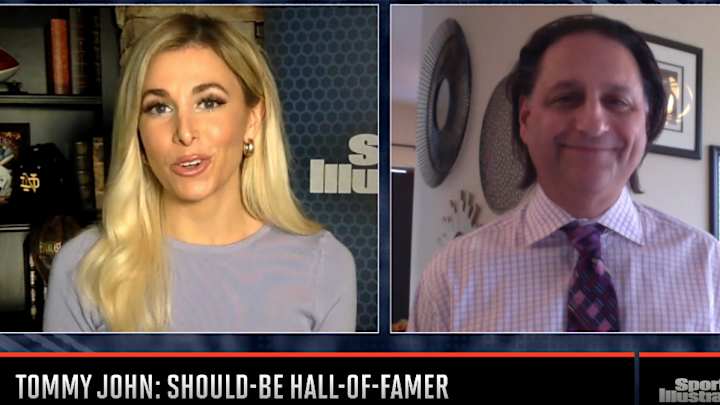They dare call it the Hall of Fame

The late, great Chicago and syndicated columnist Sidney J. Harris had a regular feature called, "Things I learned on my way to looking up other things." This is one of those things.
I was starting to do research for a piece on the 50th anniversary of the memorable-for-all-the-wrong-reasons 1970 White Sox season, when one of the first names I came across was Tommy John, whose 77th birthday is May 22. That got me to look something else up, which led to putting the 1970 piece off a bit while first writing about the most famous baseball player who ever lived.
Well, most famous major league player who ever lived. There's a guy who played for the Sox in the minors and also shot a little hoops who's more famous — but no one who made it to the show is more famous than Tommy John.
If you doubt that, just consult the ultimate authority in all things: the web. Google "Tommy John" and you get 323 million hits. Yep, 323 million. Babe Ruth gets 34 million, Mike Trout 29, Hank Aaron 22, even Yankee heartthrob Derek Jeter 15. Lou Gehrig, with a whole disease named after him, 7.5. Among pitchers, there are totals like 8.1 for Clayton Kershaw, 3.8 for Justin Verlander, 3.1 for Bob Feller, and 1.7 for the top pitcher of John's era, Tom Seaver. The only player even remotely close is Cy Young at 185 million, and that's because he has a major award named for him.
Now, there is a need to disclose that there turns out to be an underwear company named Tommy John (who knew?), which skews the results. But add the word "baseball" to each of the searches, and John is still the king, 21.3 million hits to the Babe's 13.2 (even with a candy bar named after him) and Trout's 9.9 (including all the fish hits).
How can you call something the Hall of Fame and not include by far the most famous player the game has ever known? How could he have never gotten more than 31.7% of the votes?
Sure, John's ulnar collateral ligament is more famous than the rest of him, but the rest was none too shabby. He spent 26 — 26, count 'em, 26 — years in the majors, to the age of 46, with a 288-231 record. That's the third-most wins of anyone not in Cooperstown, despite missing a year post-surgery. That includes three 20-win seasons, the last being a 21-9 gem for the Yankees when he was 35.
John had a career bWAR of 61.6, with a 3.34 ERA over 4,710 innings, 20th-most innings of all time. In seven years with the White Sox, John went 82-80 with a mostly pretty bad (OK, often awful) team, with a 2.95 ERA, including an amazing 1.98 ERA to go with a 10-5 record in 1968, admittedly the last season before pitcher dominance led to the lowering of the mound.
But the greatest fame, of course. came on the operating table.
John had been a solid pitcher for more than a decade — 124 wins —before he trusted his elbow and his career to surgeon Frank Jobe in 1974. The rest is major baseball history.
"Tommy's attitude was the special thing," Dr. Jobe said. "He didn't hesitate. He said, "'Let's do it.'"
It was be cut by the scalpel or be cut by the game, but it was unknown territory. "I was absolutely terrified before that surgery," John said.
The operation to which Tommy John gave his name — Jobe thought that was the easiest way to identify it — has, of course, become amazingly routine, to the extent John himself is against how widespread it has become.
Five hundred or so major leaguers have had TJS since 1974, with virtually all games — more than 85% — now involving at least one pitcher who has had the surgery, including one game that featured 10 of them. Latest stats showed the White Sox at 88% of games. More than a quarter of pitchers on MLB staffs in 2018 were TJS vets.
There have been several studies on how well pitchers fare after TJS, with conflicting results. An article by the National Institute of Health last September said there is a significant overall statistical decline in performance after surgery, but only because a number of pitchers don't recover much at all. Take away those who don't last a year in the majors after getting new UCLs, and the decline disappears.
It's not all those major leaguers that have led Tommy John himself to oppose most TJS's. Nowadays, 57% of all Tommy John surgeries are performed on 15-to-19 year olds, with one in seven never recovering their athletic skills. In an article in the AARP Bulletin in 2018, John strongly opposed what he sees as the cause of such massive need for an operation, the fact young athletes today concentrate too much on one sport and badly overwork the muscles involved. He may not be a doctor, but plenty in the medical field agree with him.
You've probably got lots of time on your hands right now, so Google him. Visit a few million sites that mention him, and you will never doubt he should be in Cooperstown. It's Hall of Fame, folks. Fame. And to not include the most famous major leaguer of them all — and the elbow he put on the chopping block without knowing what might happen — is ridiculous.
Happy Birthday, Tommy. You and your UCL are in our Hall of Fame. Heck, compared to you, the rest are just in the Hall of the Fairly Well Known.

Retired broadcaster/metro columnist/theatre marketer/tinker/tailor/soldier/spy. White Sox fan since first moving to Chicago in 1971 and working for Sox network home radio station.